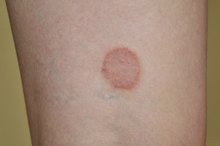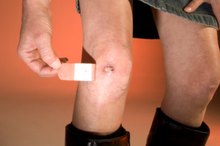What does fact checked mean?
At Healthfully, we strive to deliver objective content that is accurate and up-to-date. Our team periodically reviews articles in order to ensure content quality. The sources cited below consist of evidence from peer-reviewed journals, prominent medical organizations, academic associations, and government data.
The information contained on this site is for informational purposes only, and should not be used as a substitute for the advice of a professional health care provider. Please check with the appropriate physician regarding health questions and concerns. Although we strive to deliver accurate and up-to-date information, no guarantee to that effect is made.
Should You Bandage Ringworm?
Ringworm is a fungal skin infection, according to Medline Plus. The infection can occur almost anywhere on the body, including the scalp, groin area and feet. It is contagions and can be spread by skin-to-skin contact or by using contaminated items, such as a towel. Ringworm can also be transmitted from animals to people. If you have ringworm, you may wonder if you should cover it with a bandage to lessen the risk of passing it to someone else.
If you are experiencing serious medical symptoms, seek emergency treatment immediately.
Contain the Infection
Nationwide Children’s Hospital in Columbus, Ohio, advises against bandaging 2. The infection heals best when left open. But take care to keep people from coming in contact with the infected area or anything that has touched the infected area. Healing can take two to four weeks and possibly longer.
- Nationwide Children’s Hospital in Columbus, Ohio, advises against bandaging 2.
- The infection heals best when left open.
Apply Anti-fungal Creams
The Skin on My Big Toe Is Peeling
Learn More
Anti-fungal creams can clear up many cases of ringworm. Topical medications such as Lotrimin, Micatin and Tinactin are available over the counter. Before applying anti-fungal cream, wash and dry the infection site. After the area is clean, apply a thin layer of the medication up to twice daily. Continue applying for two weeks or longer. The Mayo Clinic recommends contacting your doctor if ringworm doesn’t improve after four weeks 1.
- Anti-fungal creams can clear up many cases of ringworm.
- Before applying anti-fungal cream, wash and dry the infection site.
Oral Treatments
If leaving the infection open and treating with anti-fungal cream doesn’t work, your doctor may prescribe an oral medication. These medications include Sporanox, Lamisil and Diflucan. Do not take any of these drugs if you are on medications for acid reflux or blood clotting.
Ringworm Prevention
Bumps in a Circle on the Skin
Learn More
Although ringworm is difficult to prevent, you can reduce your chances of future infection, according to the Mayo Clinic 1. Wash your hands often and don’t share items, such as towels. Avoid wearing heavy clothes for long periods of time, as it can create moist conditions for ringworm to live. Also, stay away from animals that have patches of hair missing, which could be ringworm.
- Although ringworm is difficult to prevent, you can reduce your chances of future infection, according to the Mayo Clinic 1.
- Also, stay away from animals that have patches of hair missing, which could be ringworm.
Related Articles
References
- Mayo Clinic: Ringworm
- Nationwide Children’s Hospital: Ringworm
- Homei A, Worboys M. Fungal Disease in Britain and the United States 1850–2000: Mycoses and Modernity. Basingstoke (UK): Palgrave Macmillan; 2013. Chapter 1, Ringworm: A Disease of Schools and Mass Schooling. Available from: https://www.ncbi.nlm.nih.gov/books/NBK169210/
- Jain A, Jain S, Rawat S. Emerging fungal infections among children: A review on its clinical manifestations, diagnosis, and prevention. J Pharm Bioallied Sci. 2010;2(4):314–320. doi:10.4103/0975-7406.72131
- Yee G, Al Aboud AM. Tinea Corporis. [Updated 2019 Jul 6]. In: StatPearls [Internet]. Treasure Island (FL): StatPearls Publishing; 2019 Jan-. Available from: https://www.ncbi.nlm.nih.gov/books/NBK544360/
- Alkeswani A, Duncan JR, Theos A. Tinea faciei starting at day two of life. Pediatr Dermatol. 2019;36(1):e20-e22.
- Furlan KC, Kakizaki P, Chartuni JC, Valente NY. Sycosiform tinea barbae caused by trichophyton rubrum and its association with autoinoculation. An Bras Dermatol. 2017;92(1):160–161. doi:10.1590/abd1806-4841.20174802
- Hay RJ. Tinea Capitis: Current Status. Mycopathologia. 2017;182(1-2):87–93. doi:10.1007/s11046-016-0058-8
- InformedHealth.org [Internet]. Cologne, Germany: Institute for Quality and Efficiency in Health Care (IQWiG); 2006-. Athlete's foot: Overview. 2015 Jan 14 [Updated 2018 Jun 14].Available from: https://www.ncbi.nlm.nih.gov/books/NBK279549/
- Nadalo D, Montoya C, Hunter-smith D. What is the best way to treat tinea cruris?. J Fam Pract. 2006;55(3):256-8.
- Das S, Barbhuniya JN, Biswas I, Bhattacharya S, Kundu PK. Studies on comparison of the efficacy of terbinafine 1% cream and butenafine 1% cream for the treatment of Tinea cruris. Indian Dermatol Online J. 2010;1(1):8–9. doi:10.4103/2229-5178.73249
- Errichetti E, Stinco G. Dermoscopy in tinea manuum. An Bras Dermatol. 2018;93(3):447–448. doi:10.1590/abd1806-4841.20186366
- Piraccini BM, Alessandrini A. Onychomycosis: A Review. J Fungi (Basel). 2015;1(1):30–43. Published 2015 Mar 27. doi:10.3390/jof1010030
- Ashraf M, Biswas J. Chronic ringworm infestation and Marjolin's ulcer, an association unknown in the literature. Rare Tumors. 2010;2(2):e31. Published 2010 Jun 30. doi:10.4081/rt.2010.e31
- Landry GL, Chang CJ, Mees PD. Treating and avoiding herpes and tinea infections in contact sports. Phys Sportsmed. 2004;32(10):43-4.
- Davis EC, Callender VD. Postinflammatory hyperpigmentation: a review of the epidemiology, clinical features, and treatment options in skin of color. J Clin Aesthet Dermatol. 2010;3(7):20–31.
- Fuller LC, Child FJ, Midgley G, Higgins EM. Diagnosis and management of scalp ringworm. BMJ. 2003;326(7388):539–541. doi:10.1136/bmj.326.7388.539
- Boral H, Durdu M, Ilkit M. Majocchi's granuloma: current perspectives. Infect Drug Resist. 2018;11:751–760. Published 2018 May 22. doi:10.2147/IDR.S145027
- Al Aboud AM, Crane JS. Tinea Capitis. [Updated 2019 Mar 2]. In: StatPearls [Internet]. Treasure Island (FL): StatPearls Publishing; 2019 Jan-. Available from: https://www.ncbi.nlm.nih.gov/books/NBK536909/
- Ely JW, Rosenfeld S, Seabury stone M. Diagnosis and management of tinea infections. Am Fam Physician. 2014;90(10):702-10.
- “Ringworm: Signs and Symptoms.” American Academy of Dermatology, American Academy of Dermatology.
- Laniosz V, Wetter DA. "What's New in the Treatment and Diagnosis of Dermatophytosis?" Seminars in Cutaneous Medicine and Surgery. 2014 Sep;33(3):136-9.
Writer Bio
Nicki Howell started her professional writing career in 2002, specializing in areas such as health, fitness and personal finance. She has been published at health care websites, such as HealthTree, and is a ghostwriter for a variety of small health care organizations. She earned a Bachelor of Science in business administration from Portland State University.








